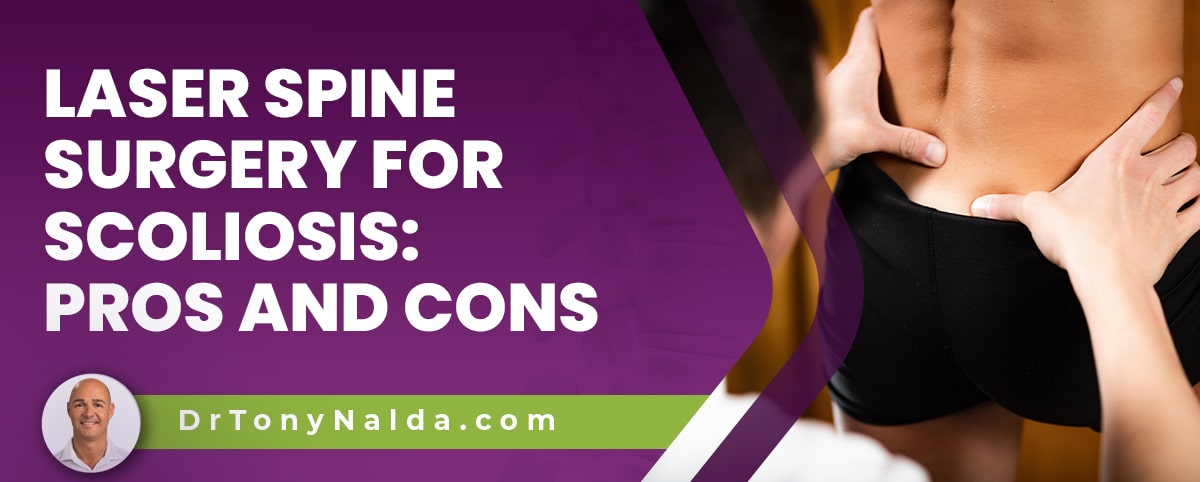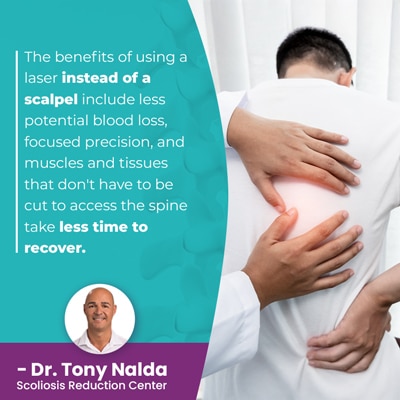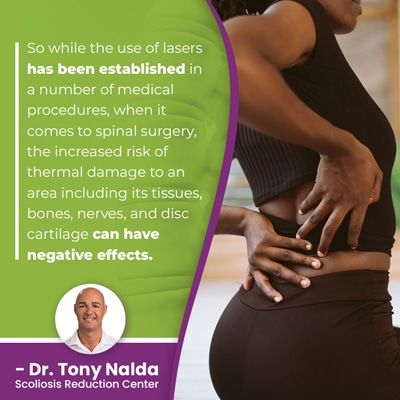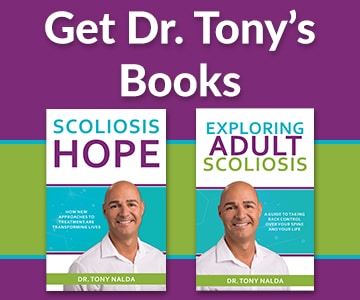Laser Spine Surgery for Scoliosis: Pros and Cons

There are different ways to treat scoliosis from traditional spinal fusion surgery to laser spine surgery and nonsurgical treatment options. Laser spine surgery relies on the use of a laser versus a scalpel, so is less invasive in that regard, but as always, every surgical procedure comes with its share of potential risks and complications.
Lasers apply intense heat capable of cutting through tissue, removing discs, deadening damaged nerves, and cauterizing blood vessels. Pros of laser spine surgery surgery can include less blood loss and easily deadening damaged nerves, and cons include a lengthier recovery period and thermal damage.
Let's start with the two treatment responses that determine whether a surgical or nonsurgical approach is being applied.
Table of Contents
Scoliosis Treatment Options
Following a diagnosis of scoliosis, the most important decision to be made is how to treat conditions moving forward.
Scoliosis causes the spine to bend and twist unnaturally, and as a progressive condition, the sideways-bending spinal curve can get worse over time.
The way scoliosis is addressed will shape how the spine functions in the future, so patients should make sure they fully understand the pros and cons of all treatment options available to them.
Nonsurgical treatment offers an alternative to surgical procedures and is proactive, conservative, and integrative; the approach combines the power of multiple treatment disciplines.
Here at the Scoliosis Reduction Center®, conservative treatment is started immediately following a diagnosis because that's when conditions are at their mildest and are likely to be the most responsive to treatment.
There are no treatment guarantees, but the milder scoliosis is when treatment is started, the fewer limits there are to what nonsurgical treatment can achieve.
Conservative treatment plans are fully customized and are shaped by how the treatment disciplines are apportioned: chiropractic care, physical therapy, corrective bracing, and rehabilitation.
Together, these treatment modalities work together to slow/stop progression, reduce curve sizes on a structural level, improve the spine's surrounding muscle balance and strength for more support and stability for the spine.
A surgical response has a different treatment goal and approach to addressing scoliosis.
Surgical Scoliosis Treatment
Conservative nonsurgical scoliosis treatment has the goal of correcting scoliosis, and surgical treatment has the goal of stopping the condition from getting worse.
Traditional spinal fusion surgery uses a scalpel and involves identifying the most-unnaturally tilted vertebrae at the curve's apex, removing intervertebral discs that sit between vertebrae to be fused, and fusing the vertebrae into one solid bone.
Metal rods are then attached to the spine with pedicle screws to hold the spine's aligned position, and hardware attached is permanent; if hardware fails for any reason or there is an adverse reaction, the only option is more surgery.
Risks associated with the procedure itself include excessive blood loss, infection, adverse reaction to hardware, and nerves damage.
Long-term risks include a spine that's rigid and less flexible, increased pain at the fusion site, and a spine that's weaker and more vulnerable to injury.
The concept of fusing the spine is contrary to the spines movement-based design, so it's bound to affect the spine in some negative ways, particularly in terms of its range of motion, strength, and long-term function.
Laser Spine Surgery
While traditional spinal fusion surgery uses a scalpel, laser spine surgery uses a laser.
Lasers can produce an intense amount of focused heat and have been useful in a number of medical procedures such as laser eye surgery and a number of cosmetic and dental procedures.
 The benefits of using a laser instead of a scalpel include less potential blood loss, focused precision, and muscles and tissues that don't have to be cut to access the spine take less time to recover.
The benefits of using a laser instead of a scalpel include less potential blood loss, focused precision, and muscles and tissues that don't have to be cut to access the spine take less time to recover.
So let's talk about the process of scoliosis surgery and how lasers are used.
As discussed, once the curve's most-tilted vertebrae are determined, these are the bones that are going to be fused together.
The discs that sit between adjacent vertebrae to be fused have to be removed, and the discs perform many key functions including making the spine more flexible, acting as shock absorbers, preventing friction during movement, and giving the spine structure.
So the removal of one or more intervertebral discs is not a small thing, and this is where the use of a laser is most commonly applied.
Discectomy
Most surgeons make a series of small punctures through which the spine is accessed and a camera is inserted.
The camera is used to guide the surgeon to the desired area and the less muscle groups, tissues, and ligaments are interfered with, the less damage they will incur during the procedure.
The laser is inserted through the incisions and its intense heat is directed to the necessary area and used to either remove a disc(s) or burn damaged nerves and tissues that are causing problems.
Instead of a scalpel being used to cut through muscle and tissues to access the spine and disc, the laser's intense heat and precision are used to remove discs and deaden damaged nerves in the area.
A damaged nerve can cause a variety of symptoms felt throughout the body so deadening problematic nerves can go a long way in terms of symptom improvement.
When a nerve is irritated, damaged, inflamed, or compressed, it can produce a number of symptoms felt anywhere along its pathway, and remember, nerves are like branches on a tree fanning off in multiple directions.
So how does the use of a laser, versus a traditional scalpel, affect surgical outcomes and recovery times?
Laser Spine Surgery Outcomes
While the use of a laser over a scalpel can seem like a less-invasive option, studies have shown that laser spine surgery comes with its own potential side effects and risks.
Studies conducted by the American Academy of Orthopaedic Surgeons extended as far back as the 1980s and found there to be no direct benefit to using lasers in spinal surgeries.
In addition, results also found that the use of lasers can actually lengthen a patient's recovery time.
In terms of laser discectomies, data showed that patient groups who had traditional disc removals had less recovery time and were also less likely to require revision surgeries; in fact, patients who had undergone laser spine surgery had a 50-percent higher incidence rate for revision surgery.
If scoliosis surgery fails for any reason, the only recourse is more surgery, and the risks increase with each subsequent procedure and increasing age.
 So while the use of lasers has been established in a number of medical procedures, when it comes to spinal surgery, the increased risk of thermal damage to an area including its tissues, bones, nerves, and disc cartilage can have negative effects.
So while the use of lasers has been established in a number of medical procedures, when it comes to spinal surgery, the increased risk of thermal damage to an area including its tissues, bones, nerves, and disc cartilage can have negative effects.
Conclusion
Here at the Center, patients benefit from a less-invasive treatment approach that doesn't involve scalpels or lasers; it involves the integration of chiropractic care, physical therapy, corrective bracing, and rehabilitation.
While there are never treatment guarantees, in most cases, the sooner treatment is started, the better.
Scoliosis only gets more complex to treat as it progresses. The spine becomes increasingly rigid, making it less responsive, and condition effects become more pronounced and difficult to reverse and/or improve.
The main effect of scoliosis in children involve postural changes such as uneven shoulders, hips, and the development of a rib cage arch, and the main effect in adults is pain.
Traditional scoliosis treatment involves a surgical response when/if conditions become severe, but little is done beforehand in a proactive effort to prevent that level of progression from occurring.
Laser spine surgery for scoliosis involves fusing the spine so it can't become more unnaturally-tilted over time (progress), and instead of using a scalpel to cut through muscle and tissue to access the spine and remove the discs, the precise and intense heat from a laser is used instead.
While the use of a laser is helpful for deadening damaged nerves and tissues, it can also cause thermal damage in the area, and studies have shown that the recovery time for laser spine surgeries is actually longer than traditional spinal fusion surgery.
Fortunately, conservative treatment results speak for themselves and support that not all cases of scoliosis require surgery.
So for patients recently diagnosed that are being told surgery is the only option, in typical cases of idiopathic scoliosis that are diagnosed early and treated early, scoliosis can be highly treatable and responsive to nonsurgical treatment.
Dr. Tony Nalda
DOCTOR OF CHIROPRACTIC
After receiving an undergraduate degree in psychology and his Doctorate of Chiropractic from Life University, Dr. Nalda settled in Celebration, Florida and proceeded to build one of Central Florida’s most successful chiropractic clinics.
His experience with patients suffering from scoliosis, and the confusion and frustration they faced, led him to seek a specialty in scoliosis care. In 2006 he completed his Intensive Care Certification from CLEAR Institute, a leading scoliosis educational and certification center.
About Dr. Tony Nalda
 Ready to explore scoliosis treatment? Contact Us Now
Ready to explore scoliosis treatment? Contact Us Now





